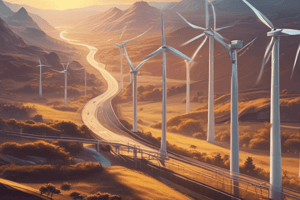Podcast
Questions and Answers
What is the primary goal of sustainable energy technologies?
What is the primary goal of sustainable energy technologies?
To provide energy sources that are replenishable and minimize environmental impact.
Name three key types of sustainable energy?
Name three key types of sustainable energy?
Solar, wind, and hydropower.
What is one major challenge associated with solar and wind energy?
What is one major challenge associated with solar and wind energy?
Intermittency.
Give an example of how process optimization can conserve energy in process industries.
Give an example of how process optimization can conserve energy in process industries.
What is biomass energy?
What is biomass energy?
Besides batteries, what is one technology used to manage intermittency from sustainable energy sources?
Besides batteries, what is one technology used to manage intermittency from sustainable energy sources?
What is one potential negative environmental impact of hydropower?
What is one potential negative environmental impact of hydropower?
Other than streamlining material handling, name one method of process optimization.
Other than streamlining material handling, name one method of process optimization.
What is waste heat recovery and how does it contribute to energy conservation in process industries?
What is waste heat recovery and how does it contribute to energy conservation in process industries?
Explain how material substitution can lead to energy conservation in manufacturing processes.
Explain how material substitution can lead to energy conservation in manufacturing processes.
Describe how upgrading equipment efficiency contributes to energy conservation in process industries. Provide an example.
Describe how upgrading equipment efficiency contributes to energy conservation in process industries. Provide an example.
How does reducing water usage in industrial processes relate to energy conservation?
How does reducing water usage in industrial processes relate to energy conservation?
Explain the role of enhanced insulation in conserving energy within industrial facilities.
Explain the role of enhanced insulation in conserving energy within industrial facilities.
What measures can be taken to optimize compressed air systems for energy conservation?
What measures can be taken to optimize compressed air systems for energy conservation?
Explain the concept of process integration and how it supports energy conservation.
Explain the concept of process integration and how it supports energy conservation.
What are some benefits observed as a result of successful implementation of energy conservation methods in process industries?
What are some benefits observed as a result of successful implementation of energy conservation methods in process industries?
Flashcards
Sustainable Energy Technology
Sustainable Energy Technology
Energy sources that replenish and reduce environmental impact.
Solar Energy
Solar Energy
Energy from sunlight converted to electricity using PV cells or CSP.
Wind Energy
Wind Energy
Electricity generation using wind turbines, available onshore or offshore.
Hydropower
Hydropower
Signup and view all the flashcards
Geothermal Energy
Geothermal Energy
Signup and view all the flashcards
Biomass Energy
Biomass Energy
Signup and view all the flashcards
Intermittency
Intermittency
Signup and view all the flashcards
Process Optimization
Process Optimization
Signup and view all the flashcards
Waste Heat Recovery
Waste Heat Recovery
Signup and view all the flashcards
Material Substitution
Material Substitution
Signup and view all the flashcards
Equipment Efficiency Upgrades
Equipment Efficiency Upgrades
Signup and view all the flashcards
Reduced Water Use
Reduced Water Use
Signup and view all the flashcards
Enhanced Insulation
Enhanced Insulation
Signup and view all the flashcards
Compressed Air System Optimization
Compressed Air System Optimization
Signup and view all the flashcards
Process Integration
Process Integration
Signup and view all the flashcards
Automation and Monitoring
Automation and Monitoring
Signup and view all the flashcards
Study Notes
Sustainable Energy Technology
- Sustainable energy technologies provide replenishable energy sources minimizing environmental impact, unlike finite fossil fuels.
- Key types include solar, wind, hydropower, geothermal, and biomass.
- Solar energy converts sunlight to electricity via photovoltaic (PV) cells or concentrated solar power (CSP).
- Wind energy harnesses wind power for electricity with onshore and offshore options.
- Hydropower uses flowing water's potential energy, often with dams.
- Geothermal energy utilizes Earth's internal heat for electricity or direct heating.
- Biomass energy uses organic matter (e.g., wood, agricultural waste) for heat or electricity.
- Challenges include intermittency of solar and wind power, significant land use for large-scale farms, environmental impact (e.g., dam construction, habitat disruption), and high initial investment costs.
- Technological advancements address these challenges through improved efficiency, energy storage (e.g., batteries, pumped hydro), smart grids, and hybrid systems.
Energy Conservation Methods in Process Industries
- Process industries (chemical, manufacturing, food processing) can reduce energy consumption through improved operations and technology.
- Conservation strategies include process optimization (adjusting temperatures, pressures, material handling), waste heat recovery, material substitution, and equipment efficiency upgrades (e.g., pumps, compressors).
- Reducing water use and enhancing insulation in pipes, equipment, and tanks lessen energy consumption. Compressed air system optimization (repairing leaks and implementing efficient controls) is crucial.
- Integrating different process units enables energy recovery from one part for use in another. Automation and real-time monitoring optimize operations.
- Economic benefits include lower utility bills, improved profit margins, and a reduced environmental footprint.
- Obstacles to implementation are initial investment costs, insufficient process data, organizational resistance to change, and a need for skilled personnel.
- Successful implementations include advanced process control systems in chemical plants and waste heat recovery in metal processing.
Studying That Suits You
Use AI to generate personalized quizzes and flashcards to suit your learning preferences.




